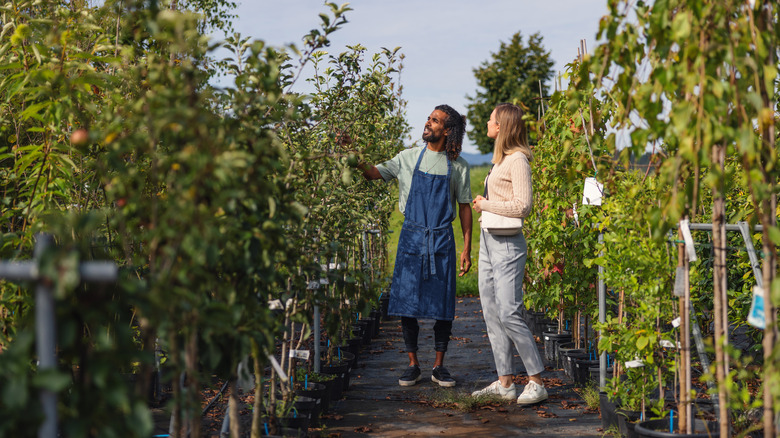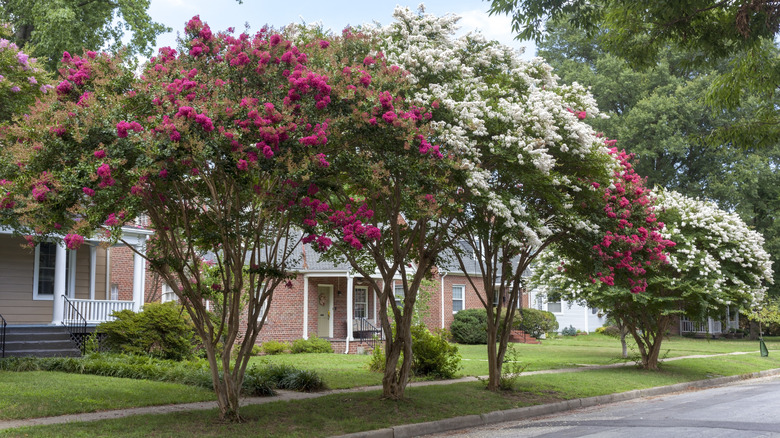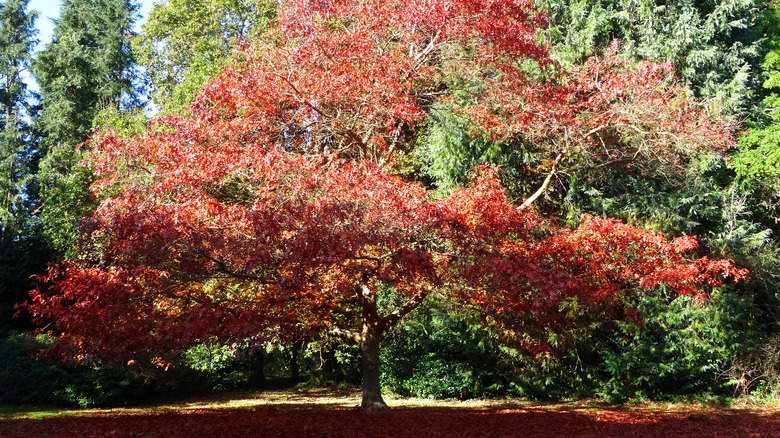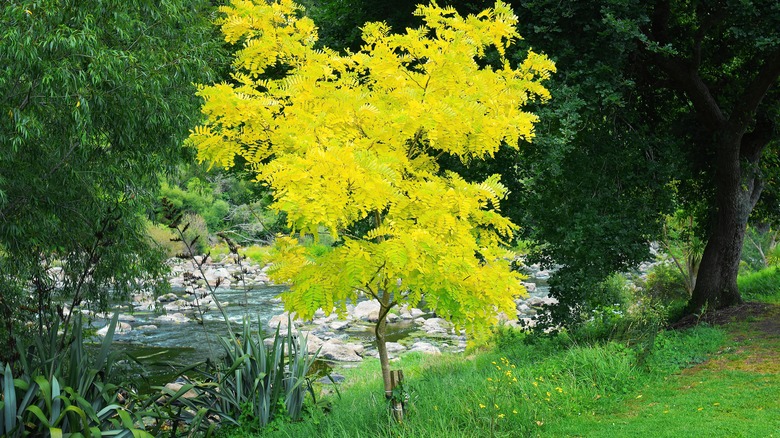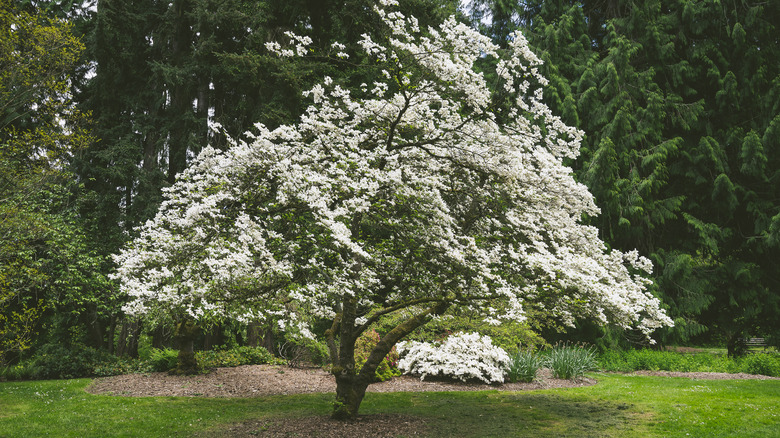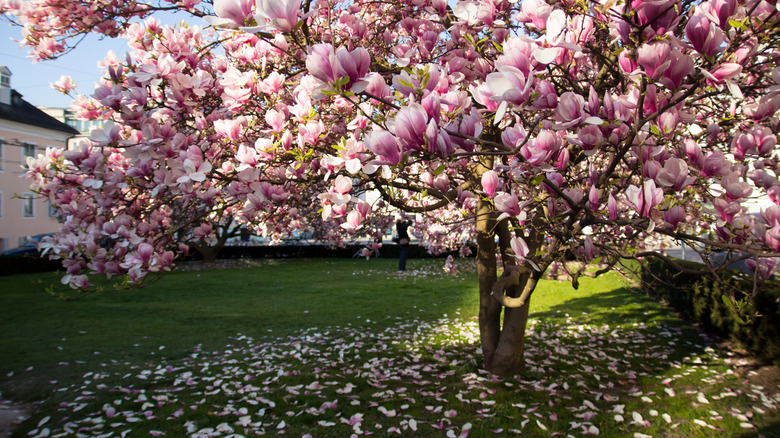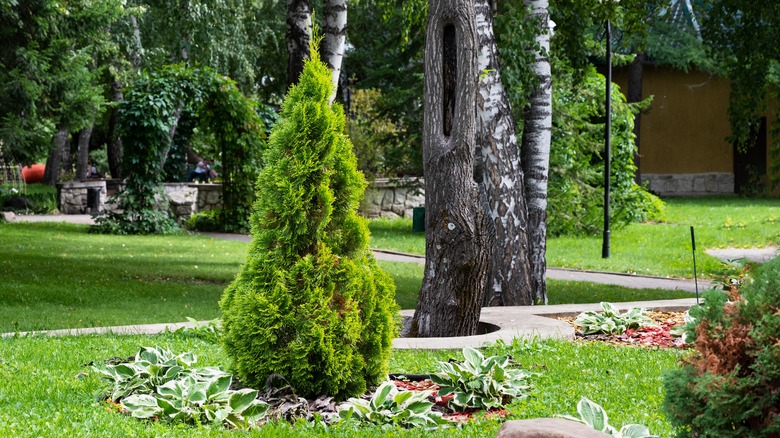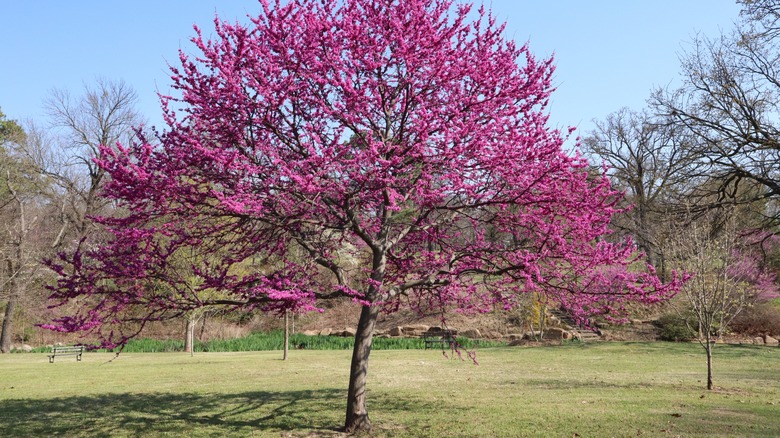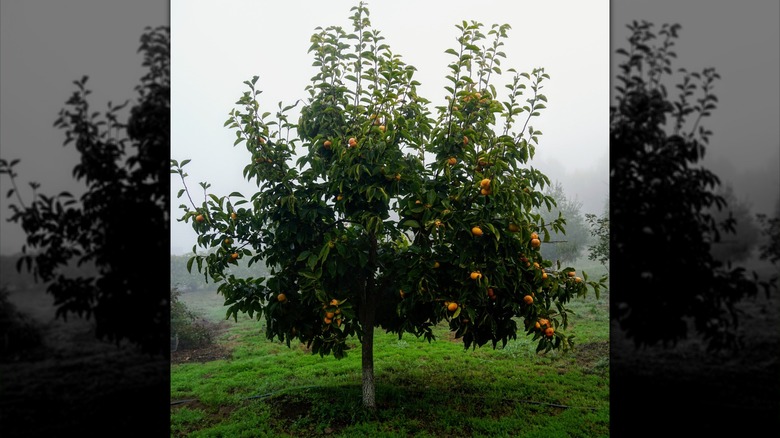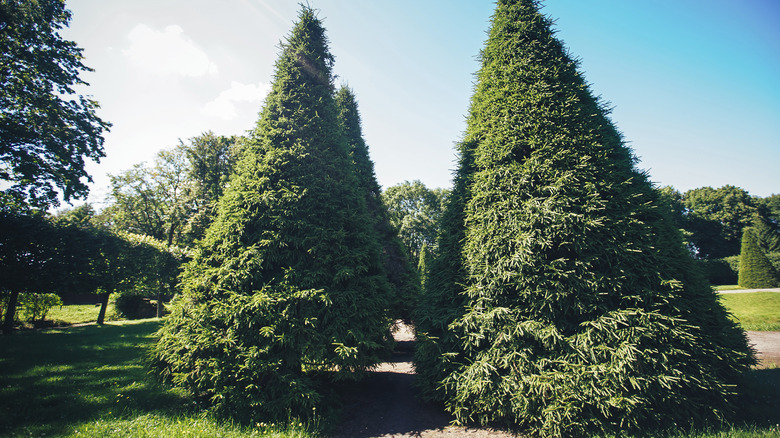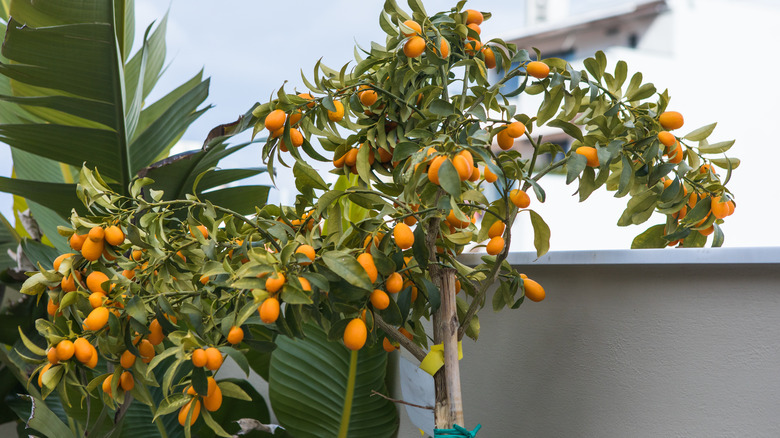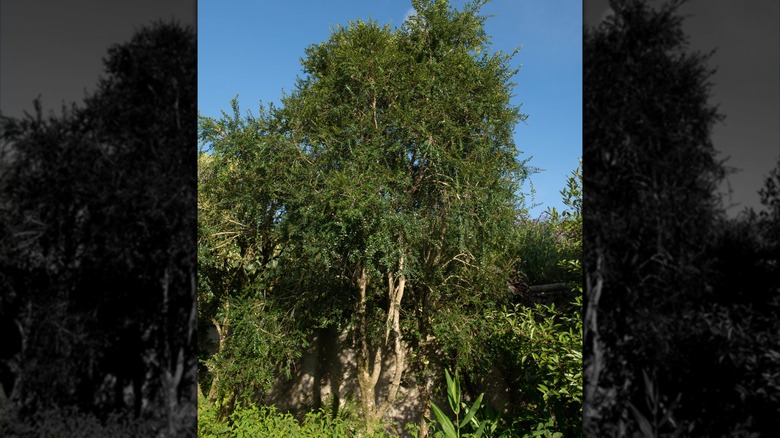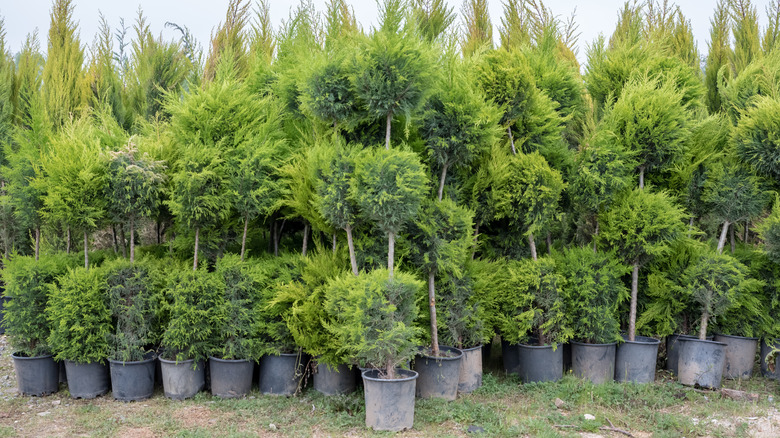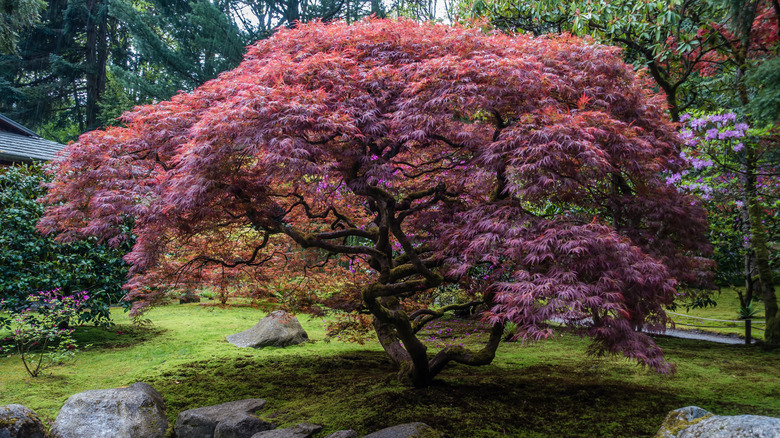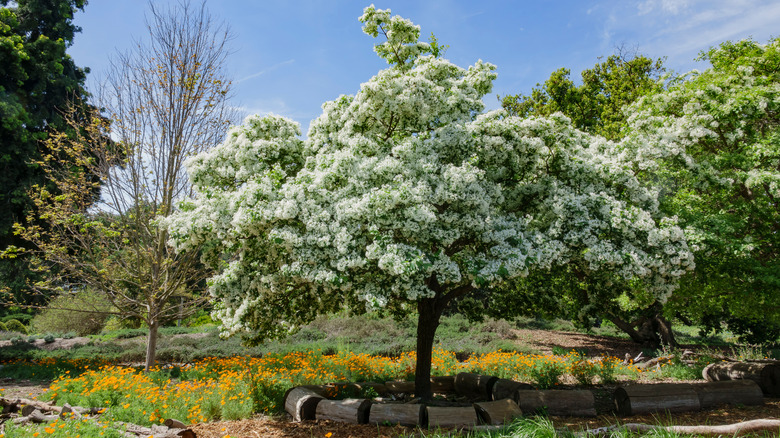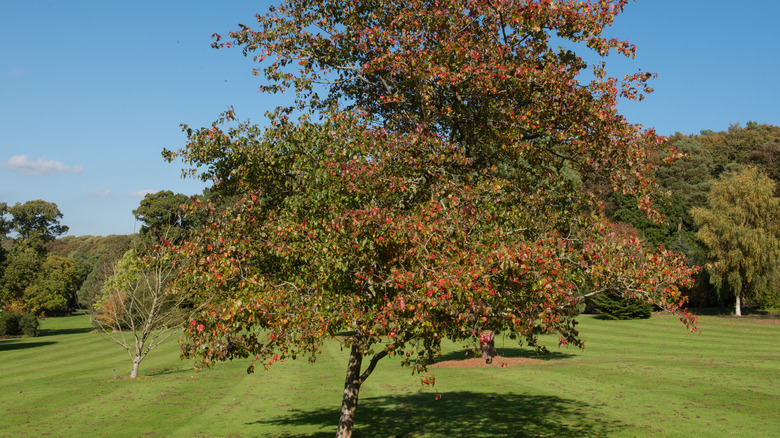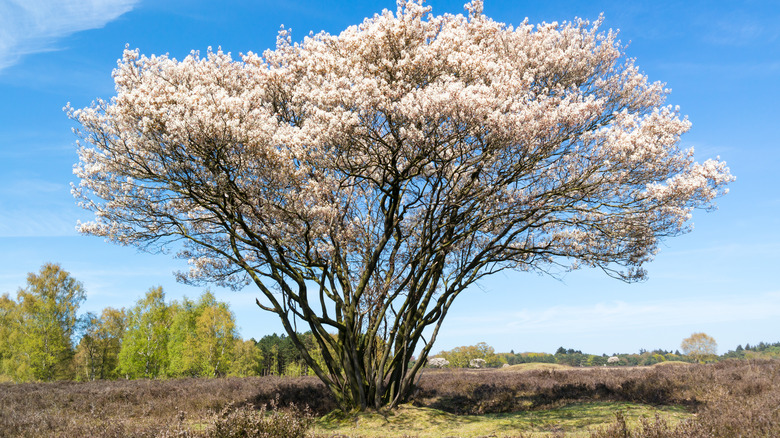16 Of The Most Affordable Tree Species That Won't Break The Bank
We may receive a commission on purchases made from links.
If you're staring down a bare spot in your yard or garden, a new tree may sound like the perfect solution, but a walk around your local nursery may give you some sticker shock — and we're not talking about grass burrs. It's no secret that landscaping trees are expensive, and some are more expensive than others. In general, native trees, ornamental trees, and softwood trees tend to be cheaper and grow faster than fruit trees or hardwoods, like oak or maple. Of course, the cost may vary depending on the specific variety of tree you choose for your yard and the retailer you decide to purchase from, but there are dozens of brilliant options available, even for under $100, from charming flowering trees to eye-catching deciduous options and evergreens perfect for privacy.
Sometimes, there's more to an affordable tree than what's on the sticker price. A budget-friendly backyard tree should also be relatively low-maintenance. Otherwise, you'll end up pouring your savings into the water bill, fertilizers, and other supplies. Here are 16 tree species that won't break the bank and the factors that make them reliable picks for gardeners and landscapers on a budget.
1. Crepe myrtle
Crepe myrtles (Lagerstroemia indica) are some of the most accessible and affordable trees on the market; a 3-gallon Miss Sandra crepe myrtle tree is just over $51 at Home Depot. They thrive in USDA zones 6 to 9 and produce lovely summer blooms in shades of pink, white, lilac, or red, depending on the variety. Crepe myrtles also grow quickly, so you can purchase a smaller sapling and watch it grow into a full-sized tree in a few years. Plus, once you establish a healthy tree, you can propagate more crepe myrtles for a healthy, colorful yard.
2. Northern red oak
Native to North America, the northern red oak (Quercus rubra) is one of the more affordable oak tree species you can plant in your yard. A 3-gallon northern red oak sapling is just under $60 at Lowe's. Plus, it offers some beautiful and classic fall foliage. This tree will do well in USDA zones 3 to 8 and is surprisingly low maintenance for all its beauty. Compared to other oaks, the northern red oak is relatively fast-growing and can reach magnificent heights between 60 and 80 feet when mature.
3. Honey locust
The honey locust tree (Gleditsia triacanthos), also known as the thorny locust, is a deciduous tree native to North America. Honey locust trees thrive in USDA zones 4 to 8 and can reach up to 100 feet tall. This tree's large seed pods and gorgeous golden color in fall make it a unique, affordable choice for gardens. Honey locust trees can have thorns, so if you're looking for a more kid-friendly or pet-friendly tree, consider some thornless honey locust varieties, such as this honey locust sapling available for just over $28 at Walmart.
4. Dogwood
Flowering dogwood trees (Cornus florida) are a very popular, affordable option for gardens and residential areas. Native to the eastern half of North America, these trees produce dainty white or pink blooms in spring that contrast beautifully with their dark brown trunk and limbs. Flowering dogwoods will do well in USDA zones 5 to 9 and are great for attracting a variety of pollinators and other wildlife. A young 2 to 3-foot white-flowering dogwood tree is as low as $10.95 from The Tree Store, while a 3-gallon pink-flowering dogwood is just over $59 at Lowe's.
5. Magnolia
That's right; this classic beauty can actually be one of the more affordable trees to plant in your backyard. Magnolia refers to a number of flowering trees in the Magnolia genus, which will generally grow around USDA zones 4 to 10. There are many types of magnolias, but smaller varieties tend to be cheaper, such as the magnolia Jane, priced at just over $40 at TN Nursery. If you're looking for something that will grow to be a little more magnificent, you can still pick up a 7-gallon Southern Magnolia (Magnolia grandiflora) at Lowe's for under $96.
6. Emerald Green arborvitae
Emerald Green arborvitae (Thuja occidentalis 'Smaragd') is a cultivar of Thuja that provides lovely, dense, soft, and vibrant green foliage, making it an affordable, popular choice for privacy. Emerald Green arborvitae will survive in USDA zones 3 to 7 and tend to grow rather quickly, putting on between 1 to 2 feet per year within the first few years. However, These trees grow to be around 10 to 15 feet tall at most, so they won't overwhelm your small yard or garden space. A 3-gallon Emerald Green arborvitae is just over $54 at Home Depot.
7. Eastern redbud
The eastern redbud tree (Cercis canadensis) is native to North America and thrives in zones 5 through 9, depending on the cultivar. With deep red-violet blooms and a rounded canopy between 15 and 20 feet wide, this gorgeous tree is the perfect pop of color for a small backyard. If the showy pink flowers aren't enough to win your heart, many cultivars of this tree also fade to beautiful gold and red colors in fall. A 5-gallon eastern redbud sapling is just under $73 from Lowe's and can bring beauty to your yard for 50 to 75 years.
8. Persimmon
If you're looking for edible fruit trees that won't break the bank, a persimmon tree could be an excellent choice for your yard or garden. There are many types of persimmon trees, such as the Japanese persimmon, American persimmon, or Texas persimmon, all members of the Diospyros genus. The fuyugaki or fuyu Asian persimmon is one especially popular choice for landscaping and does well in USDA zones 7 to 10. A 1-gallon fuyugaki persimmon sapling from Lowe's is $45. This tree will grow to around 20 to 30 feet in height once mature, producing sweet orange-colored fruits every fall.
9. Green Giant Thuja
Similar to Emerald Green, the Thuja Green Giant (Thuja standishii x plicata) is another affordable tree great for filling in empty space, creating a natural windbreak, or providing privacy. However, as the name implies, this evergreen tree grows quite large — up to 60 feet tall when mature — and rather quickly, too, putting on as much as 3 feet per year. This hybrid tree prefers slightly cooler climates and will do well in USDA zones 5 to 7. A 1-gallon Thuja Green Giant is under $25 at Lowe's.
10. Kumquat
Kumquats are charming, low-maintenance fruit trees belonging to the Fortunella genus and are closely related to oranges, lemons, and other citrus fruits. These trees need bright, sunny environments and will generally grow well in USDA zones 9 and 10. Kumquat trees produce tiny orange fruits that provide a nice ornamental look and can be eaten whole, having a strong, tart flavor. Most kumquat trees only grow between 8 and 12 feet tall, so they can be suitable fruit trees for small backyards and patios. The Nagami kumquat tree is one popular variety, available at Four Winds Growers for $60.
11. Box-leaf azara
The box-leaf azara (Azara microphylla) is a small evergreen of the Salicaceae family, shared with willow trees. Box-leaf azara trees typically grow to a maximum height between 12 and 20 feet, and they're hardy in USDA zones 8 to 10. From February to March, this unassuming tree comes to life with delicate yellow blooms that smell like vanilla or chocolate to some. The Box-leaf azara's fountain-like shape makes it a good choice to provide light shade in a garden or offer some privacy. A 2-gallon box-leaf azara tree is just under $27 from Dancing Oaks Nursery and Gardens.
12. Leyland cypress
Leyland cypress (Cupressus × leylandii) is an affordable evergreen and coniferous tree that provides a similar look to thujas but with a bit more adaptability. With their rich, bright, and soft foliage that's easy to sculpt into desired shapes, these plants are frequently grown as hedges but can reach up into trees if permitted. Like other similar trees, leyland cypress are fast growers and can gain up to 3 feet per year, and eventually, the tree may be as high as 50 feet tall. A 2-pack of 2.25-gallon leyland cypress trees is just over $70 at Home Depot.
13. Japanese maple
For a stunning look that won't cost an arm and a leg, the Japanese maple tree is a popular and eye-catching choice. This unique tree boasts beautiful red leaves for most of the year, not just in the fall. Most Japanese maples will survive between USDA zones 4 and 8, but it's important to select a variety that suits your particular climate. Some of these can be a little pricier, depending on the variety, but overall, Japanese maples are relatively affordable and accessible. You can find an 18- to 24-inch Bloodgood Japanese maple at Walmart for around $40.
14. White fringe tree
For those enamored by the mimosa tree, the white fringe tree (Chionanthus virginicus) provides a similar fairytale look without introducing an invasive plant to your neighborhood. Chionanthus virginicus is native to southern and eastern portions of the United States and grows beautifully in USDA zones 3 through 9. When mature, this tree will usually reach between 12 and 20 feet tall, with a lovely canopy spreading as far as 20 feet. In late spring, it will explode with fragrant and fluffy white blooms. You can order an 8- to 12-inch tree from Old House Trees for $18.
15. Washington hawthorn
Hawthorn (Crataegus), also known as quickthorn or thornapple, is a small thorny tree that's actually part of the rose family. The Washington hawthorn (Crataegus phaenopyrum) is a species native to North America and a good choice for bringing interest and color to your yard at an affordable price. These deciduous trees can survive in USDA hardiness zones 4 through 8 and provide nice seasonal displays — from reddish leaves in early spring to green leaves and white flowers in the summer — with scarlet berries in winter. A 3 to 4-foot tree is just under $33 from Green Thumbs Garden.
16. Serviceberry
The serviceberry tree (Amelanchier), also known as shadbush, shadwood, or saskatoon, is a popular native fruiting berry bush that grows up to 25 feet tall. This low-maintenance garden tree can grow in a wide range of conditions, surviving between USDA zones 2 through 8, depending on the distinct species. Its white spring blooms are a buffet for pollinators, and juicy summer berries also make it one of the plants that are most likely to bring mourning doves to your yard. You can pick up a set of two serviceberry trees for under $50 at Walmart.
